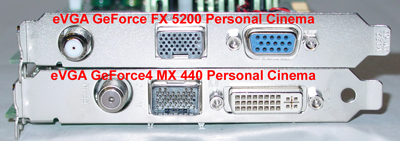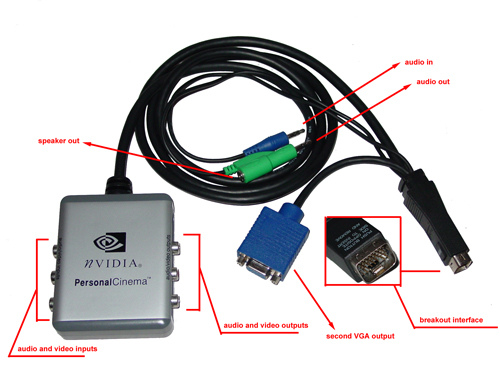NVIDIA GeForce FX Personal Cinema Roundup - Asus, Chaintech, eVGA, and MSI
by Andrew Ku on December 23, 2003 10:48 AM EST- Posted in
- GPUs
NVIDIA GeForce4 and GeForce FX Personal Cinema Breakout Design
Both the GeForce4 and GeForce FX based Personal Cinema cards use the same 40-pin breakout design, though it is implemented differently on the newer GeForce FX based cards. The difference is the use of male and female connectors and the orientation of the security tab. GeForce4 based cards use a male connector on the card and the GeForce FX, a female connector. The change is due to cost of service support. If pins were to break off the card, the card would naturally need to be replaced. Since the male connector is now on the breakout cable, the cable can be easily swapped out for a new one if damage occurs to the pins. This helps bring the cost of service down, since the card costs a lot more to replace than the breakout cable.The other change is to the method of securing the breakout cable to the card. The GeForce4 based Personal Cinema cards have a divot on the bottom side of the 40-pin connector housing that allows the breakout connector to be fastened securely to the card. This was necessary because the loss of signal due to a loose cable during a recording would just be unacceptable. The problem with the orientation of this was that users need to twist their thumb to hold down the security tab to release the cable (on tower systems). Ergonomically speaking, the tab should be on the top side of the cable due to the way things are naturally held in our hands. This has been since corrected for the GeForce FX based Personal Cinema cards. Personally, we prefer the security screw pins that the ATI uses on their breakout cable for the All-in-Wonder 9600 Pro. This is a much simpler and user-friendly method to secure the cable.
The breakout cable features a second VGA output for dual monitor support because the TV tuner takes up a considerable amount of space. The breakout box on the cable houses composite video input/output, s-video input/output, and composite audio input/output. It would have been preferable to have the video/audio out and in divided into two separate breakout connectors because the video/audio in isn't going to be as common a task as video/audio out, which will always be needed for TV audio. This separation will help save on clutter, should video/audio in not be used.
NVIDIA GeForce4 and GeForce FX Personal Cinema
NVIDIA GeForce FX Personal Cinema – Dual Display Support












6 Comments
View All Comments
Webgod - Sunday, January 11, 2004 - link
Where's the review? Where's the comparison of screenshots of live TV with both the Personal Cinema and ATI AIW cards? How does it compare to your TV set side by side? How do the ATI AIW's compare to the Personal Cinema cards with PVR functions, etc.? Go more in depth, this is Anandtech.bschuler2004 - Monday, December 29, 2003 - link
Nvidia sure does make some crappy AIW imitators! I thought they'd be worse than ATI, but not THIS bad. It's shocking to say the least. I'd rather have an original AIW rage IIC card then one of these garbage cards.How on earth do they honestly intend to sell this junk with a straight face? It's laughable.
jruff - Wednesday, December 24, 2003 - link
PC CLub recommened the nVidia card which is what I built for my mothers computer. Going over tomorrow t o run thru the software. For my wife's machine I just bought a AIW 9600 Pro that I will be installing tomorrow. Shhhh, its a christmas present ;)I couldnt find much on the nVidia when I put her new system together I was just going on what PC Club said. Ill get a chance to use both here in the next week putting together the 6 Digital 8 tapes I have managed to make in the last year of my sons life (birthday jan 8, 1 year)
We will se how it goes and which makes the easiest final product.
Stay tuned :)
LoneWolf15 - Wednesday, December 24, 2003 - link
Interesting, but I do get a little tired of bundling all of these products with the video card. I want to keep a TV tuner/PVR for the long haul, and every time graphics technology changes, buying a new all-in-one card would break my budget. That, and the fact that NVidia only offers these features on their low-end cards means I'd rather choose one of ATI's solutions, despite some issues with their software. The All-in-Wonder line now spans from the entry-level AIW 7500 and 9000 on up to the top. ATI has a much better tiered structure, and also has standalone tuner/capture cards (TV Wonder Pro).morcegovermelho - Tuesday, December 23, 2003 - link
Good review. Very good info on breakout box, remote control, and Dual Display Support.Maybe should be included in the review some info about video-capture.
What capture format? MPEG2? AVI? Other format?
If capture is mpeg2, what resolution? what bitrate? Is it DVD-compliant?
If capture is avi, what is the codec? Can it be uncompressed? Can we use DivX? It's a proprietary codec?
How about dropped frames?
Audio capture - 44khz or 48Khz? Uncompressed, mp2 or ac3 ?
sandorski - Tuesday, December 23, 2003 - link
I just kinda skimmed the article, but I saw enough to support my conclusion(I think ;) ): Nvidia has a long road to catch up to ATI in regards to Multimedia/Multifunction vidcards. It's not just in technology though, but also reputation.It wasn't too long ago when Multifunction was all ATI had, they certainly weren't selling their cards for Gaming Performance reasons. No serious Gamer would even consider them.
OTOH Nvidia and 3DFX were engaged in a bitter battle for the Gaming Performance crown. We all know how that turned out ( :( ).
Nvidia won the Crown and all seemed good....until ATI released the Radeon 9700 Pro. That one card turned the video card world on its' ear and NVidia has been trying to catch up since.
ATI's time relying on and perfecting their AIW and lesser MultiMedia functioning cards had allowed them to focus on Gaming Performance. They acheived that and the Marketplace is begining to turn on to the whole Multimedia/Multifunction idea in a big way.
Nvidia has a long road ahead and seems to be trying to desperately catch up on a number of fronts. Hopefully they can for Competitions sake, but ATI is turning into a Juggernaut.